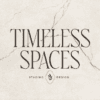When working with our team, the group assigned to your project will collaborate on a concept for your brand visuals. This concept is based on:
- Your questionnaire responses (Your personal taste & brand story)
- Current trends in your industry
- Distinguishing you from your competition
- How the client should “feel” when they are ready to purchase
The concept that we come up with is sketched out with a “mood board”. The mood board contains everything from logo style examples, to images and colours that showcase the direction that we are thinking of taking your project. This step is a STATUS CHECK. We don’t want to spend billable hours creating customized logos and brand elements for a concept the client doesn’t like. So the mood board is a great way to show a general idea of what we are thinking and ensure that we are on the same page with the client’s vision, preferences and expectations.
Your account manager will ask you for feedback about your mood board. There may be things you LOVE or things that fall flat. This is okay. The mood board is supposed to be a visual aid to a more specific conversation. The more that you share, the more likely we can create a final design that you love. Don’t be scared or nervous to say if you don’t like something.
After you receive your mood board, you can take a day or two to think about it, but we encourage you to not over-think it. Self-doubt kills creativity. Email your account manager any final thoughts or feedback that you have. Your project will not move to the next stage until you approve it.
A Common Mood Board Mistake:
A mistake that some clients make, is taking their mood board too literally. It’s GENERAL showing syles, and ideas to provoke conversation. Just because you see a certain logo shape, doesn’t mean that we will duplicate the exact same logo. That said, if there is something you love on the board, we might be able to include it as it is.
What If You Don’t Like Your Mood Board?
If you madly dislike your mood board – don’t panic. While this can feel disappointing, it’s part of the process. We are all trying to create something that we have never seen before, and the creative process sometimes has dead ends. If the whole mood board is a flop, let your account manager know that this isn’t close enough to what you were envisioning, and the design team will try again. If this occurs, the more feedback you give, the better! Let us know that you don’t like how bright, moody, dark, simple, or expensive it looks. Your designer will not be offended if you send along images or colour samples that you like.
The next step in this process is your brand pitch…
A Sample Mood Board:
Here you can see an example of a mood board that we provide to clients. It shows examples of the styles we are thinking, as well as images that communicate the feel, colours and concepts we are leaning towards. There are comments along the right side to give more insight into the designer’s thoughts.







